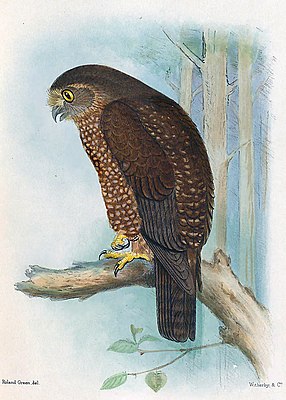Norfolk Island Cuckoo Owl
| Norfolk Island Cuckoo Owl | ||||||||||||
|---|---|---|---|---|---|---|---|---|---|---|---|---|

Norfolk Island Cuckoo Owl, from The Birds of Australia . Picture by Henrik Grönvold (1858–1940). |
||||||||||||
| Systematics | ||||||||||||
|
||||||||||||
| Scientific name | ||||||||||||
| Ninox novaeseelandiae undulata | ||||||||||||
| ( Latham , 1802) |
The Norfolk Island cuckoo owl ( Ninox novaeseelandiae undulata ) was a subspecies of the New Zealand cuckoo owl ( Ninox novaeseelandiae ) native to New Zealand's South Island . In pure form, it is considered extinct. Hybrids , the genes of 1,996 dead last purebred female bear within them, still live on in the Tasman Sea nearby Norfolk Island .
features
With a length of 30 cm, the Norfolk Island cuckoo owl was slightly larger than the nominate form . The plumage was rust-brown on the top, reddish-brown and banded white on the underside. The wings were banded beige-brown and white. The head and throat were russet. The face veil was whitish to yellow-brown. The beak was blue-black. The feet were dull yellowish brown. The iris was golden yellow. In contrast to the nominate form, the upper side was more rusty brown and the underside more reddish brown banded.
Habitat and way of life
The Norfolk Island cuckoo owl used to inhabit the subtropical rainforests of the Norfolk Island. Due to the extensive clearing of the forests, its area of distribution had shrunk in 1909 to an area of 4.65 km² on Mount Pitt. Cuckoo owls breed in tree hollows. The Norfolk Island cuckoo owl laid two to three eggs, but usually clutches of two eggs. The diet consisted of small vertebrates, especially birds and mammals, as well as invertebrates.
Extinction and Hybridization

The disappearance of the Norfolk Island cuckoo owl began with the change in forest habitats by humans. But also the competition for tree hollows with introduced honey bees ( Apis ) and Pennant parakeets ( Platycercus elegans ) has severely affected the population. In the 1960s, the shape was classified as "critically endangered" after biologists neither heard nor sighted the birds. Calls were recorded in 1973, 1978 and 1985 and local residents claimed to have heard at least one of the calls. A thorough search in October 1986 found a surviving female named Miamiti in honor of the matriarch of Norfolk Island. After DNA analysis showed that the Norfolk breed and the New Zealand nominate form are genetically most closely related, two males of the New Zealand breed were brought to Norfolk Island. One male disappeared without a trace. The second male, however, mated with Miamiti, so that in December 1989 the first N. n. Undulata / novaeseelandiae hybrids were born. Miamiti died in 1996. By crossing the hybrids with each other, the population in 1999 comprised 35 owls.
literature
- Warren B. King on the behalf of the International council for bird preservation (ICBP) and the Survival service commission of IUCN (1978-1979): Red Data Book 2: Aves (2nd edition). IUCN, Morges, Switzerland, ISBN 0-87474-583-7 .
- Penny D. Olsen , NJ Mooney & Jerry Olsen: Status and Conservation of the Norfolk Island Boobook Ninox novaeseelandiae undulata. In: Raptors in the Modern World . Meyburg, B.-U. & Robin Chancellor (Eds.): WWGBP: Berlin, London & Paris, 1989 (PDF, Online; 11.8 MB)
- Claus König & Friedhelm Weick : Owls of the World. 2nd Edition. Christopher Helm, London 2008, ISBN 978-0-7136-6548-2 .
- Julian P. Hume , Michael P. Walters : Extinct Birds. P. 199, A&C Black 2012, ISBN 140815725X .